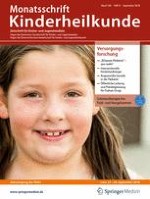Erschienen in:

01.08.2018 | Opioide | CME
Schmerztherapie bei Früh- und Neugeborenen
verfasst von:
Dr. M. Richter, Dr. B. Seipolt
Erschienen in:
Monatsschrift Kinderheilkunde
|
Ausgabe 9/2018
Einloggen, um Zugang zu erhalten
Zusammenfassung
Auf der neonatologischen Intensivstation (NICU) ist Schmerz ein zentrales Thema. Akute wie anhaltende (kontinuierliche, chronische) Schmerzen sind häufig. Da validierte Biomarker oder physiologische Schmerzmessinstrumente, wie Speichelkortisol, Hautwiderstand oder Herzfrequenzvariabilität, bisher fehlen, kann Schmerz in der Neonatologie aktuell nur über die Fremdbeobachtung eingeschätzt werden. Dies erfolgt durch eine regelmäßige, standardisierte Nutzung von Schmerzskalen (Scores). Schmerz und Medikamente (Analgetika/Sedativa) können sich in dieser vulnerablen Zeit negativ auf die Hirnentwicklung auswirken. Daher stehen die Reduktion der Anzahl an Schmerzreizen und der medikamentöse Leitsatz „So viel wie nötig, so wenig wie möglich“ im Vordergrund. Bei anhaltendem (kontinuierlichem, chronischem) Schmerz sind die Reduktion der Analgetika und Sedativa sowie die Vermeidung von Entzugserscheinungen weitere Herausforderungen.